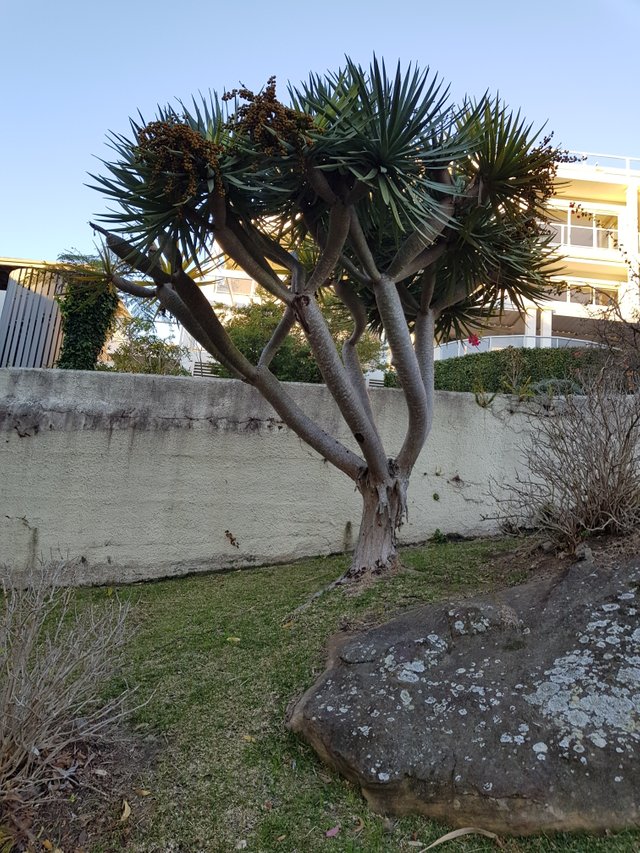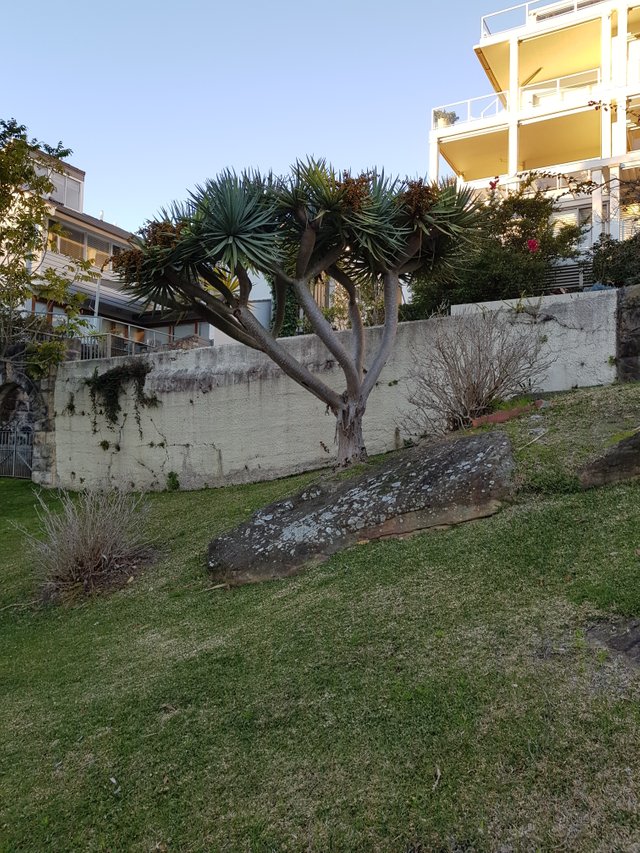Dragon Tree.
Dracaena draco ( Dragon Tree ) is sometimes also called the Dragon's Blood Tree because when the leaves or stems are cut, the sap is red. These plants are slow growing and very long-lived. Older plants have many branches and end up with an umbrella-like shape and flat on top. They are drought tolerant once established and prefer temperate to warm climate, a sunny position and well drained soil. This spectacular specimen plant is growing in a waterfront reserve on Sydney Harbour.


Dragon tree is a palmlike member of the agave family, related to Spanish bayonet (Yucca aloifolia), and century plant (Agave americana). The overall shape is that of an umbrella with a thick, swollen trunk and many stout, upright branches each terminating with a rosette of stiff, sword shaped leaves about 2 ft (60 cm) long.
Mature plants produce terminal clusters of greenish flowers, followed by round reddish orange fruits. In cultivation dragon tree barely gets 20-30 ft (6-9 m) tall, but in its native habitat 50 ft (15 m) tall specimens are not uncommon.
Dracaena draco is native to the Canary Islands, an archipelago of seven volcanic islands in the Atlantic Ocean about 160 miles (100 km) off the northwest coast of Africa. In its native habitat, dragon tree is an endangered species (listed as "Vulnerable") due to over collecting for its red colored resin, called "dragon's blood".
Dragon tree is grown as an ornamental throughout the world in Mediterranean climates, and is very popular in southern California.
Source
Silly Sausage Award !! You selected great Pics and nice information. Thanks.
Dracaena draco , also known as the “Dragon Tree”, or “Dragon's Blood Tree” is a drought-tolerant tree-like plant that can grow to become an stunning garden specimen or indoor plan. Native to the Canary Islands, Cape Verde, and Madeira, Dracaena draco grows a ringed succulent trunk topped by clustered flexible sword-like blue-green leaves. Generally unbranched until it flowers, Dracaena draco then produces branches from the sides of its inflorescence. The leaf scars on its trunk resemble a reptile’s skin, and when cut, the tree ‘bleeds’ a deep red sap known as ‘Dragons Blood’, which can be used to stain wood.
Dracaena draco , the symbol of the island of Tenerife, grows well in full sun or part shade, and needs good drainage. It adapts well to container growing, and is hardy down to the low 20s or high teens Fahrenheit. Hardy and drought tolerant, Dracaena draco can adapt well to extreme heat, winds and ocean salty weather.
http://www.cycadpalm.com/dracaena-draco-plants.html
The Dragon tree is often planted as a special interest feature plant in ornamental landscapes and gardens in many parts of the Inland Empire. Over time it will grow into a medium size tree with a stout succulent trunk up to 25 ft. tall.
As plants mature, they develop broad crowns comprised of many branches extending outward to form a bold canopy shape. Gray-green foliage is comprised of 2 ft. long sword-shaped leaves; creamy-white flowers occur in large spikes above the foliage and are followed by bright orange berries.
Native to Mediterranean climates on the Canary Islands, the dragon tree is one of the most unusual plants for ornamental landscapes. It is highly adapted to warm and sunny climate exposures and easily adapts to annual summer drought.
It shows sensitivity to cold temperatures below 25°F and should be planted in warm microclimate areas. Young plants are often grown in containers and raised planters to display their character as their trunks mature.
Like other succulent-type plants, the dragon tree grows best in well-drained soils with infrequent summer watering. It takes many years to achieve tall and large specimen stature, but it is well worth the effort as few plants provide such unique character.
Resources
The dragon's blood plant (Dracaena draco) is not the friendliest or most beautiful of houseplants. But it has the single most important quality for your indoors foliage—it is tough beyond all measure. It has somewhat severe, stiffly pointed leaves that end in something resembling a spike. The leaves are solidly green, and the plant will grow to a height of 3 or 4 feet indoors.
The dragon's blood name comes from the fact that it exudes reddish resin from wounds and nicks. As a point of interest, it is said that this resin was used as a wood dye to stain the famous Stradivarius violins. It is a member of the agave family and is related to the yucca and century plant.
Native to the Canary Islands, these plants appreciate excellent drainage—the quickest way to kill it is to waterlog the roots. Watch out for leaf-tip browning, which can be corrected by using non-fluoridated water.
Source: https://www.thespruce.com/grow-dracaena-draco-1902753
The Dragon tree is often planted as a special interest feature plant in ornamental landscapes and gardens in many parts of the Inland Empire. Over time it will grow into a medium size tree with a stout succulent trunk up to 25 ft. tall. As plants mature, they develop broad crowns comprised of many branches extending outward to form a bold canopy shape.
Gray-green foliage is comprised of 2 ft. long sword-shaped leaves; creamy-white flowers occur in large spikes above the foliage and are followed by bright orange berries.
Native to Mediterranean climates on the Canary Islands, the dragon tree is one of the most unusual plants for ornamental landscapes. It is highly adapted to warm and sunny climate exposures and easily adapts to annual summer drought

. It shows sensitivity to cold temperatures below 25°F and should be planted in warm microclimate areas. Young plants are often grown in containers and raised planters to display their character as their trunks mature.
Source
Lovely Pics !
Dracaena draco is a woody, evergreen tree monocot that can grow to about 10-15 m in height (but exceptionally up to 21 m tall and up to 15 m in circumference at the base of the trunk). Both trunk and branches produce large, compact clusters of silvery gray leaves.

Silvery-grey, smooth dichotomously branched. When young the stem is single. At about 10-15 years of age the stem stops growing and produces a flower spike. Soon a crown of terminal buds appears and the plant starts branching.
Generally has a large central trunk that with age may develop a number of side branches subtending a hugely wide semiglobose umbrella-shaped canopy. Not to be confused with Dracaena cinnabari, the Dragon Blood Tree native to Socotra.
Each branch grows for about 10–15 years and re-branches, so to determine its age one has to know roughly how often they flower, once every ten to 15 years (maybe more frequently in the Azores), and count the number of branches, so the age of the tree can only be estimated by the number of branching points before reaching the canopy.

http://www.llifle.com/Encyclopedia/SUCCULENTS/Family/Dracaenaceae/22863/Dracaena_draco
Oh, yes, a beautiful plant @ctrl-alt-nwo and Dracaena draco (Dragon Tree) - An attractive and an interesting succulent tree that is commonly used as a house plant, but if planted in the ground in our near frost free climate it will grow to a massive and broad tree that is 25 feet tall and as wide and, with great age, even larger - one of the tallest ever recorded was over 70 feet tall. The terminal ends of the thick branches hold clusters of 2 foot long by 1 1/2 inch wide pliable sword-shaped blue-green leaves. In early summer appear the greenish-white flowers that are followed by orange berries. This plant remains unbranched until it flowers or is otherwise damaged and then produces two large heavy branches on either side of the inflorescence. When the bark is cut or bruised the sap flows as a reddish colored resin. This resin , one of the sources of a substance known as Dragon's blood can be used to stain wood. Plant in full sun or part shade. Water infrequently and deeply - do not allow the root zone to remain wet as this is the easiest way to kill this plant. It is hardy to about 20-25 degrees F - our tree in front of the nursery had foliage damaged but no lasting damage our in our 1990 freeze at 18 °F.
A very hardy and drought tolerant tree that tolerates extreme heat, winds and salt spray. This plant is native to the Canary Islands, Cape Verde, Madeira, and western Morocco and is the natural symbol of the island of Tenerife, the largest of the Canary Islands. It is on Tenerife where one can find the "Drago Milenario" (Thousand Year old Draco), a famous giant dragon tree located in Parque del Drago in Northern Tenerife that is believed by many people to be over a thousand years old, but others estimate it to be in the hundreds. Since monocots such at this do not form growth rings, the actual age of the plant is unknown, though the tree was declared a national monument in 1917. This species is on the International Union for Conservation of Nature (IUCN) List of Threatened Species Red List as Vulnerable (A1a-e) meaning that it is facing a high risk of extinction in the wild in the medium-term future for numerous reasons (loss of habitat, exploitation, competition etc). The name Dracaena comes from the Latin word 'draco', meaning "dragon" that was already used for the specific epithet for this same plant. This new name was ascribed by Linnaeus in 1767 when he renamed the plant originally called Asparagus draco. This species received the coveted Royal Horticultural Society's Award of Garden Merit (AGM) in 2002.
We have been growing this plant since 1982 and have a 30 year old specimen along the street at our nursery entrance. Though not included on most posionous plant lists, some references claim that seed of the Dracaena draco is posionous, while others such as on the California Poison Control System, list it as safe plant. Since this contradictory information exists, we err on the side of caution, and list it as poisonous, though we cannot verify the validity of this or what the posionous active ingredient would be. This description is based on our research and observations made of this plant as it grows in our nursery, in the nursery garden and in other gardens that we have visited.
https://www.smgrowers.com/products/plants/plantdisplay.asp?plant_id=530